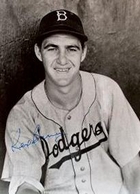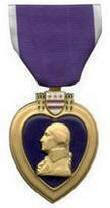Rex Barney
Ballplayers Wounded in Combat
| Date and Place of Birth: | December 19, 1924 Omaha, NE |
| Date and Place of Death: | August 13, 1997 Baltimore, MD |
| Baseball Experience: | Major League |
| Position: | Pitcher |
| Rank: | Sergeant |
| Military Unit: | 4th Armored Division and 6th Armored Division US Army |
| Area Served: | European Theater of Operations |
Rex E. Barney was born on December 19, 1924, in Omaha, Nebraska. He was
an all-round athlete at Creighton Prep and signed with the Brooklyn
Dodgers for a $2,500 bonus in 1943.
The 18-year-old right-hander joined the Durham Bulls of the Class B
Piedmont League where he was 4-6 with an earned run average of 3.00. In
late July, he was promoted to the Montreal Royals of the Class AA
International League and made his major league debut with the Dodgers
against the Chicago Cubs on August 18, 1943. On his first pitch, Barney
hit Eddie Stanky squarely in the back. He made eight starts and despite
his wildness – something that would plague him throughout his career –
he was considered an outstanding prospect.
Nevertheless, military service would delay his advance. He joined the
Army in September 1943, and served at Fort Riley, Kansas. Playing
baseball with the Fort Riley Centaurs, Barney’s teammates included Pete
Reiser, Lonnie Frey, Ken Heintzelman, Harry Walker and Al Brazle. Not
surprisingly, the team got off to an 18-1 start in 1944.
In September 1944, Barney played in the annual semi-pro tournament with
the Wichita Coleman Lamp Rangers and was chosen as an All-American. Ray
Dumont - National Baseball Congress President – named Barney as the
greatest prospect either in or out of the majors.
In January 1945, Barney arrived in Europe and served with the 4th and
6th Armored Divisions in France and Germany. He was the commander of a
lead tank, roaming the advance positions to draw enemy fire from sunup
to sundown. One day there was a commotion to the rear and a jeep
appeared alongside Barney's tank. It was General George C. Patton. “I
recognized him immediately,” Barney recalled. “He was my idol. He was
sitting behind a 50-caliber machine gun.”
They saluted, and Patton said, “Sergeant, where is the front?”
“General,” Barney responded, “the front of this tank is the front.”
“That’s too goddamn close for me! Carry on,” Patton said, and the Jeep
turned around and headed in the opposite direction.
Barney suffered shrapnel wounds to his leg and back while in service in
Europe. He received two Purple Hearts and a Bronze Star.
Aged just 21, Barney was back with the Dodgers in 1946. After two
seasons where he struggled with wildness and injuries, his 1948 campaign
was a glimpse at was had been predicted for him by so many. Barney went
15-13 with a 3.10 ERA. He hurled four shutouts and 12 complete games.
September 9 was the crowing point of that season with a no-hitter
against the New York Giants. He threw 75 strikes among his 116 pitches
as he held the Dodgers’ cross-town rivals hitless in a 2-0 victory on a
rainy night at the Polo Grounds. He walked two and struck out four, and
he had even the Giants' fans cheering.
Weeks later, Barney broke a leg in two places sliding into second base.
The injury healed, but his pitching rhythm was never the same. He
pitched his last game in the major leagues in September 1950, at the age
of just 25. Following two seasons in the minors with Fort Worth and St.
Paul, Rex Barney's playing days were over. He began a career in
broadcasting. In 1964, Barney joined the Baltimore Orioles’ organization
and later became the team’s much-loved public address announcer. It was
a position he held for 25 years until his death on August 13, 1997. Rex
Barney was 72 years old, and is buried in Lorraine Park Cemetery,
Woodlawn, Maryland.
Date Added December 21, 2017
Can you add more information to this biography and help make it the best online resource for this player? Contact us by email
Read Baseball's Greatest Sacrifice Through The Years - an online year-by-year account of military related deaths of ballplayers
Baseball's Greatest Sacrifice is associated with Baseball Almanac
Baseball's Greatest Sacrifice is proud to be sponsored by



